Resident Crews of the Mir
![]()
Mir: Expedition 16 |
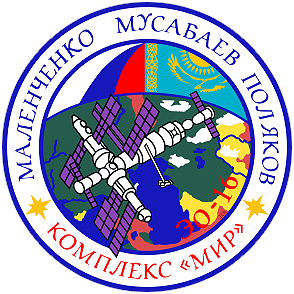 |
![]()
Crew, launch- and landing data
| No. | Nation | Surname | Given names | Position | Spacecraft (launch) |
Launch date |
Launch time |
Spacecraft (landing) |
Landing date |
Landing time |
Mission duration |
Orbits |
| 1 | Malenchenko | Yuri Ivanovich | Commander | Soyuz TM-19 | 01.07.1994 | 12:24:50.055 UTC | Soyuz TM-19 | 04.11.1994 | 11:18:25 UTC | 125d 22h 53m 35s | 1993 | |
| 2 | Musabayev | Talgat Amangeldyyevich | Flight Engineer | Soyuz TM-19 | 01.07.1994 | 12:24:50.055 UTC | Soyuz TM-19 | 04.11.1994 | 11:18:25 UTC | 125d 22h 53m 35s | 1993 | |
| 3 | Polyakov | Valeri Vladimirovich | Doctor Cosmonaut | Soyuz TM-18 | 08.01.1994 | 10:05:34.081 UTC | Soyuz TM-20 | 22.03.1995 | 04:03:50 UTC | 437d 17h 58m 17s | 6927 |
Backup Crew
| No. | Nation | Surname | Given names | Position |
| 1 | Viktorenko | Aleksandr Stepanovich | Commander | |
| 2 | Kondakova | Yelena Vladimirovna | Flight Engineer | |
| 3 | Arzamazov | German Semyonovich | Doctor Cosmonaut |
Expedition Report
|
Launch from the Baikonur Cosmodrome landing 88
km northeast of Arkalyk. For the first time for 17 years (mission Soyuz 25), the crew was a rookie crew without any spaceflight experience. Following a two-day solo flight Soyuz TM-19 docked with the Mir space station on July 03, 1994. Soyuz TM-19 docked at the rear port of the Kvant module (vacated by Progress M-23 on July 02, 1994) at 13:55:01 UTC. Main goal of the mission was the partly exchange of the resident crew. Both cosmonauts and Doctor Cosmonaut Valeri Polyakov became the 16th resident crew. The crew conducted medical experiments (research of problems of weightlessness in long-term mission) and experiments in materials science, Earth observation, astrophysics and biotechnology. Progress M-24 arrived at Mir on August 27, 1994 but ran into problems. The freighter's first automatic docking attempt failed. During the second attempt, on August 30, 1994 Progress M-24 bumped into Mir's forward longitudinal port two to four times at low speed, then drifted away. On September 02, 1994 Yuri Malenchenko took manual control of Progress M-24 using a control panel on Mir. A TV on Mir displayed an image of the station's front port transmitted from cameras on Progress M-24; the same image appeared on screens in the TsUP. In an impressive demonstration of remote piloting, Yuri Malenchenko docked Progress M-24 without additional incident. Yuri Malenchenko and Talgat Musabayev performed the first EVA on September 09, 1994 (5h 06m). The cosmonauts inspected the docking port struck by Progress M-24 - it proved to be undamaged - and mended a thermal blanket torn when Soyuz TM-17 struck the station on January 14, 1994. They also prepared equipment for moving the Kristall solar arrays to Kvant, and affixed test materials to Mir's exterior. The second and final spacewalk occurred on September 14, 1994 (6h 01m) by the same cosmonauts. They carried out assembly work connected with the ongoing effort to move Kristall's solar arrays to supports on Kvant. Yuri Malenchenko and Talgat Musabayev also inspected the Sofora girder. The cosmonauts did a lot of minor repairs, replacements of bolts, screws, etc. of platforms and equipment on the outer surface of the complex. They also spoke about an old antenna. Activities of that kind must be done now and then, but have been often neglected during EVA's due to more important matters. The cosmonauts also did some preparatory work aimed at the future transfer of the solar batteries from Kristall to Kvant1. This transfer has been put back again, now even to the beginning of 1995. There have been many problems during this mission, which finally ended with the first successful manual docking of a Progress supply ship at the station by Yuri Malenchenko. On October, 06, 1994, Mir-17 (Aleksandr Viktorenko and Yelena Kondakova) arrived at Mir together with ESA astronaut Ulf Merbold aboard Soyuz TM-20, Valeri Polyakov was again to remain aboard on his record duration flight. During final approach, Soyuz TM-20 yawed unexpectedly. He assumed manual control and completed docking without incident. Yelena Kondakova, the mission rookie, was the third Russian female cosmonaut and the first female to take part in a long-duration flight. Ulf Merbold was a physicist and veteran of two U.S. Space Shuttle missions. The month-long EuroMir 94 experiment program was considered a precursor to the ESA Columbus module planned for the joint U.S.-Russia-ESA-Japan-Canada space station. Ulf Merbold's program was planned rapidly, final agreement between ESA and Russian having been concluded in November 1992. It was also constrained by funding limitations - ESA budgeted only about $60 million for EuroMir 94. Because of these limitations, Ulf Merbold relied heavily on equipment left on Mir by earlier French, Austrian, and German visitors to the station, as well as the Czech-built CSK-1 materials processing furnace. He also used equipment delivered by Progress M-24 and Soyuz TM-20. Ulf Merbold's experiment program included 23 life sciences, 4 materials sciences, and 3 technology experiments. On October 11, 1994 the six cosmonauts aboard Mir were unable to activate a video camera and TV lights while recharging Soyuz TM-20's batteries. A short circuit had disabled the computer which guided Mir's solar arrays, forcing the station to drain its batteries. The cosmonauts used reaction control thrusters on the Soyuz TM-spacecraft docked to the station to orient it so its solar arrays would point toward the Sun, and switched on a backup computer. Normal conditions were restored by October 15, 1994. Ground teams rescheduled Ulf Merbold's experiments to allow completion of those interrupted by the power problems, and moved experiments using large amounts of electricity to the end of Ulf Merbold's stay. In addition, the Czech-built CSK-1 furnace malfunctioned, forcing postponement of five of Ulf Merbold's experiments until after his return to Earth. On November 03, 1994 Talgat Musabayev, Yuri Malenchenko, and Ulf Merbold undocked in Soyuz TM-19 and backed 190 m from Mir. They then activated the Kurs automatic approach system, which successfully redocked the spacecraft. The cosmonauts then transferred back to Mir. The test was related to the difficulties Soyuz TM-20 and Progress M-24 experienced during their automatic approaches. Final undocking and reentry the following day occurred without incident. The Soyuz spacecraft is composed of three elements attached end-to-end - the Orbital Module, the Descent Module and the Instrumentation/Propulsion Module. The crew occupied the central element, the Descent Module. The other two modules are jettisoned prior to re-entry. They burn up in the atmosphere, so only the Descent Module returned to Earth. Having shed two-thirds of its mass, the Soyuz reached Entry Interface - a point 400,000 feet (121.9 kilometers) above the Earth, where friction due to the thickening atmosphere began to heat its outer surfaces. With only 23 minutes left before it lands on the grassy plains of central Asia, attention in the module turned to slowing its rate of descent. Eight minutes later, the spacecraft was streaking through the sky at a rate of 755 feet (230 meters) per second. Before it touched down, its speed slowed to only 5 feet (1.5 meter) per second, and it lands at an even lower speed than that. Several onboard features ensure that the vehicle and crew land safely and in relative comfort. Four parachutes, deployed 15 minutes before landing, dramatically slowed the vehicle's rate of descent. Two pilot parachutes were the first to be released, and a drogue chute attached to the second one followed immediately after. The drogue, measuring 24 square meters (258 square feet) in area, slowed the rate of descent from 755 feet (230 meters) per second to 262 feet (80 meters) per second. The main parachute was the last to emerge. It is the largest chute, with a surface area of 10,764 square feet (1,000 square meters). Its harnesses shifted the vehicle's attitude to a 30-degree angle relative to the ground, dissipating heat, and then shifted it again to a straight vertical descent prior to landing. The main chute slowed the Soyuz to a descent rate of only 24 feet (7.3 meters) per second, which is still too fast for a comfortable landing. One second before touchdown, two sets of three small engines on the bottom of the vehicle fired, slowing the vehicle to soften the landing. On November 04, 1994 Ulf Merbold again squeezed into the Soyuz TM-19 descent module, together with the Mir-16 crew of Yuri Malenchenko and Talgat Musabayev, and 16 kg of the life sciences samples he collected during his stay on the station. Additional samples - including materials processing samples to be produced when the Mir-17 cosmonauts carry out the experiments Ulf Merbold was to have conducted during his stay - were to be returned to Earth by Space Shuttle Atlantis in mid-1995. Soyuz TM-19 undocking, deorbit burn, reentry, and landing occurred without significant incident. |
EVA data
| Name | Start | End | Duration | Mission | Airlock | Suit | |
| EVA | Musabayev, Talgat | 09.09.1994, 07:00 UTC | 09.09.1994, 12:06 UTC | 5h 06m | Soyuz TM-19 | Mir - Kvant2 | Orlan-DMA No. 18 |
| EVA | Malenchenko, Yuri | 09.09.1994, 07:00 UTC | 09.09.1994, 12:06 UTC | 5h 06m | Soyuz TM-19 | Mir - Kvant2 | Orlan-DMA No. 25 |
| EVA | Musabayev, Talgat | 13.09.1994, 06:31 UTC | 13.09.1994, 12:32 UTC | 6h 01m | Soyuz TM-19 | Mir - Kvant2 | Orlan-DMA No. 18 |
| EVA | Malenchenko, Yuri | 13.09.1994, 06:31 UTC | 13.09.1994, 12:32 UTC | 6h 01m | Soyuz TM-19 | Mir - Kvant2 | Orlan-DMA No. 25 |
Relocations of Manned Spacecrafts
| Spacecraft | from | Undocking | Time UTC | to | Redocking | Time UTC |
| Soyuz TM-19 | Mir - Kvant | 02.11.1994 | 10:40:10 | Mir - Kvant | 02.11.1994 | 11:14:57 |
Photos / Graphics
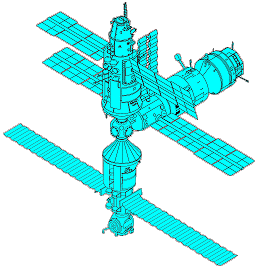 |
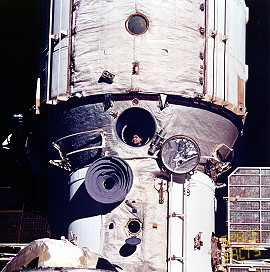 |
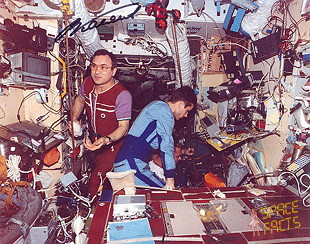 |
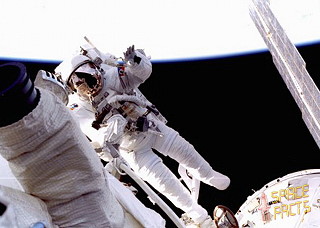 |
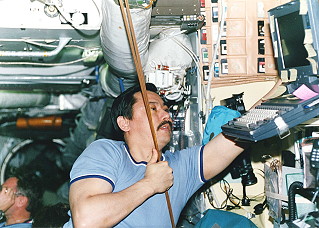 |
| © |  |
Last update on April 01, 2025.  |
 |